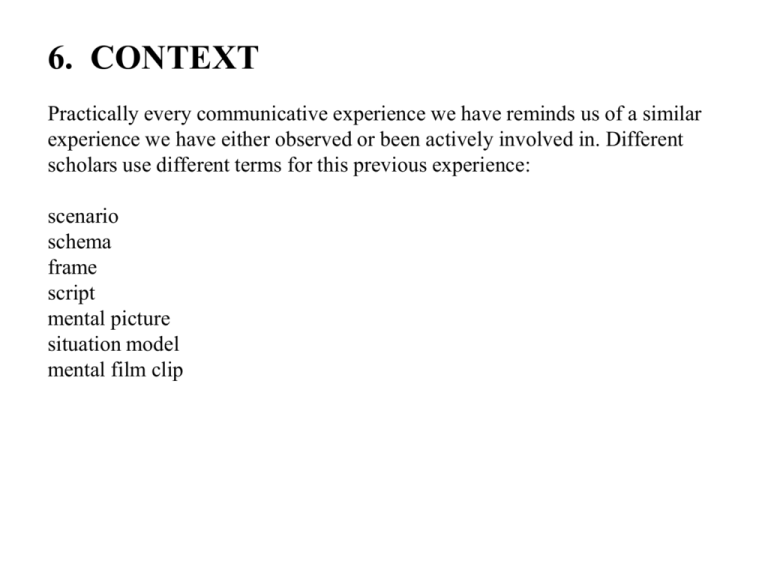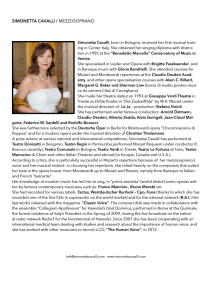Presentazione di PowerPoint
advertisement

6. CONTEXT Practically every communicative experience we have reminds us of a similar experience we have either observed or been actively involved in. Different scholars use different terms for this previous experience: scenario schema frame script mental picture situation model mental film clip On 9 October 2015 you switch on the TV and hear someone say: NATO leaders have issued a warning to President Putin as the anti-terrorist offensive continues. What kind of communicative event is this? Who is speaking? How is he/she dressed? Who is President Putin? Who are the “terrorists”? Where are they? What has been going on to make NATO leaders want to issue a warning? You can now predict the kind of language that will follow. Which of the following (A to F) are probable utterances in the context of the scenario/schema/mental film clip you now have in your head? NATO leaders have issued a warning to President Putin as the anti-terrorist offensive continues. Turkish President Recep Erdogan threatened… A. to look for an alternative supplier of natural gas. B. to give Mr Putin a punch on the nose. C. to put laxatives in Turkish kebabs exported to Russia. D. to cancel the construction of a Russian-built nuclear power station. E. to commit Turkish troops to NATO’s presence in the Baltic states. F. to sing “Vladimir, Vladimir, watch out for the jihad-ee, dear.” Even if you have never been personally involved in certain communicative events, your knowledge of the world means that you would know what to expect (in terms of participants, behaviour and language) in these situations: 1. Going through passport control at the United states border. 2. You are driving on a very busy road. The man behind you keeps flashing his headlamps but it is impossible for you to go any faster. At a red traffic light he draws level with you and opens his window. 3. You applied for a job and along with about 200 other candidates took an written test. Now you have been called to an interview. 4. Your best friend has been trying to have a baby for five years. Now she gives you the good news: she’s pregnant. Technical terms Top-down and bottom-up processing Intertextuality Remember Dell Hymes’ SPEAKING model: Setting (situation, scene) Participants (active and passive) Ends (purposes, goals, intentions) Acts (form and content of what is said) Key (tone, spirit, manner) Instrumentalities (type of spoken or written channel) Norms (socially or culturally determined norms) Genres (types of discourse) Context and Translation “[…] from the translator’s point of view, an understanding of the context is necessary so that he or she can relate what is said to the surrounding features and clarify any elements that may seem ‘out of place’ or even incomprehensible in other circumstances.” (Taylor, p. 78) M.A.K. Halliday’s Functional Grammar (FG) Conventional grammar (whether prescriptive or descriptive) merely tells us what is formally possible in the language. FG also considers the context of situation, i.e. how the cultural and situational context influences our choice of lexicogrammatical forms. You need to know about Italian culture and specific situations in order to understand: “Due caffè macchiati, per favore, poi tre ristretti, due lunghi e anche un caffè corretto.” “Quel ragazzo rischia di prendere sette in condotta.” And you need to know about UK society to understand: “My daughter’s going to Latin America for her gap year.” “When I retire I’m going to help the Samaritans for a few hours each week.” Halliday’s context of situation has three components: field, tenor and mode. FIELD involves the WH- questions. What is happening? Where and When? Who are the participants? Why are they behaving and speaking in this way? TENOR refers to the relationships between participants (boyfriend/girlfriend, boss/employee, neighbours, colleagues, complete strangers etc.) and questions of power, status and how well they know one another. It also refers to role structure: questioner/answerer, host/guest etc. MODE concerns the language used: written or spoken, spontaneous or planned, formal or informal, general or specialized etc. Context of situation and translation The translator must first of all understand the field, tenor and mode of the source text, then recreate them in the target text. Only then can s/he make the most appropriate lexicogrammatical choices. This is top-down processing. Sometimes in the translation it may be necessary to give an explicit explanation of something that has no equivalent in the target language culture: gap year, sette in condotta, Italy’s coffee culture etc. However, as we saw in Lesson 1 and the passage from Tim Park’s novel Tongues of Flame, it may be better not to explain things that do not really contribute to the reader’s appreciation of the target text (cricket nets, sixth-form college and A levels are not explained). Try to describe the field, tenor and mode in the following very brief texts from advertsements. This is an example of intertextuality. 1. Let’s beat it. Here comes that skinny dame. 2. Men hate the sight of me, I’m so skinny. I’m going to try ironized yeast. fermento con ferro aggiunto A FEW WEEKS LATER 3. You’re gorgeous since you’ve gained weight! THOUSANDS OF SKINNY GIRLS GAIN 10 TO 20 LBS. – QUICK! 4.5-9 chili Read Taylor’s summary (pp 80-83) of Juliane House’s Model of Translation Quality Assessment. She proposes: Three dimensions of language user: geographical origin, social class, time Five dimensions of language use: medium, participation, social role relationship, social attitude, province The model is best applied to spoken language/dialogue. In fact Taylor quotes House’s application of the it to a work of drama (Sean O’Casey’s play The End of the Beginning) but it could also be applied to the ironized yeast advertisement. CONTEXT AND SYNONYMY Within a language perfect synonyms rarely exist. Apparent synonyms can have subtle shades of meaning that differentiate them. Two words may have similar denotations but one is used in a greater range of contexts than the other. Or sometimes one word has connotations that the other does not. In English think of small/little or complete/finished. We have these shirts in four sizes: extra large, large, medium and _______. I only speak a _____ German. A man in love is not complete until he’s married. Then he’s finished. In Italian think about intelligente/astuto, sufficiente/abbastanza, delicato/fragile, rapido/veloce, galera/carcere/prigione. Between languages “synonyms” are even less reliable: guess = indovinare, supporre, credere, pensare rat = ratto, topo leaf = foglia, foglio, sfogliare strike = colpo, sciopero, colpire, picchiare Wimbledon = una zona di Londra, un torneo di tennis canadese = a Canadian, a pizza, (in Sardinia) a tracksuit cornetto = a brioche, an icecream, a musical instrument, (in Naples) a lucky charm in the shape of a horn Sanremo = a town in Liguria, a popular music festival POLITICAL CORRECTNESS Today we talk about African Americans or Afro-Americans. It is still acceptable to call them Blacks but we can no longer say Negroes, which was the preferred expression until about the 1960s. The word Nigger is absolutely taboo but black rap and hiphop artists use the form Nigga(h). The noun cripple and the adjective crippled can no longer be applied to people, although they can be used metaphorically to refer to an institution, an organization or an economy. Handicapped is used less and less. Disabled is still OK but some people prefer differently abled. The word gay (denotation: allegro) was adopted by homosexuals because they wanted a positive term to counter all the derogatory words used to describe them (faggot, queer etc.). A word that traditionally has negative connotations can be reclaimed and given a positive meaning. An example is spinster (zitella). Il vostro docente di Traduzione Lingua Inglese 1 è diversamente giovane. GENDER AND TRANSLATION Beware of the “generic masculine”, i.e. the use of a masculine term to refer to both males and females collectively. This occurs in Italian with plural nouns like figli and fratelli (translated as children and brothers and/or sisters). A singular masculine noun may be used in bureaucratic forms (e.g. “lo studente” in the traditional exam registers before we had ESSE3). In English the generic masculine concerns pronouns: Written notice in a hotel: “If a guest requires an invoice he should inform reception on arrival”. In written English we can use (s)he or he/she or he or she. In spoken English we often sacrifice grammatical correctness in order to preserve political correctness: If someone requires an invoice they should inform reception on arrival. When translating into Italian you can take advantage of the fact that Italian is a pro-drop language. Feminine nouns such as actress and manageress are disappearing; actor and manager are generally used for women as well as men. Should we call Professor Del Zompo il rettore or la rettrice? Lexical cohesion/Semantic fields – Taylor pp 88-91 Pragmatics – Taylor pp 91-93. You can also find a file of the slides used in my Discourse Analysis course for the 2nd year of Lingue e culture per la mediazione linguistica in 2014-15. Breakfast at Tiffany’s by Truman Capote (1958) Colazione da Tiffany, traduzione di Bruno Tasso (2007) When they reached her door she rummaged her purse in search of a key, and took no notice of the fact that his thick lips were nuzzling the nape of her neck. At last, though, finding the key and opening her door, she turned to him cordially: ‘Bless you, darling – you were sweet to see me home.’ ‘Hey, baby!’ he said, for the door was closing in his face. ‘Yes, Harry?’ ‘Harry was the other guy. I’m Sid. Sid Arbuck. You like me.’ ‘I worship you, Mr Arbuck. But good night, Mr Arbuck.’ Mr Arbuck stared with disbelief as the door shut firmly. FIELD TENOR MODE Quando raggiunsero la porta, lei cominciò a frugare nella borsa alla caccia di una chiave; senza badare alle labbra di lui che le massaggiavano la nuca, all’attaccatura del collo. Finalmente, trovata la chiave e aperta la porta, si voltò verso di lui, cordialissima. «Che Dio ti benedica, caro… sei stato davvero gentile ad accompagnarmi a casa.» «Ehi, pupa!» fece lui, perché il battente gli si stava chiudendo in faccia. «Sì, Harry?» «Harry era quell’altro. Io sono Sid. Sid Arbuck. E ti piaccio.» «Vi adoro, signor Arbuck. Buona notte, signor Arbuck.» Arbuck rimase e guardare, incredulo, la porta che era stata chiusa con gesto deciso. Mr Arbuck stared with disbelief as the door shut firmly. ‘Hey, baby, let me in, baby. You like me, baby. I’m a liked guy. Didn’t I pick up the check, five people, your friends, I never seen them before? Don’t that give me the right you should like me? You like me, baby.’ He tapped on the door gently, then louder; finally, he took several steps back, his body hunched and lowering, as though he meant to charge it, crash it down. Instead, he plunged down the stairs, slamming a fist against the wall. Just as he reached the bottom, the door of the girl’s apartment opened and she poked out her head. ‘Oh, Mr Arbuck…’ He turned back, a smile of relief oiling his face: she’d only been teasing. ‘The next time a girl wants a little powder-room change,’ she called, not teasing at all, ‘take my advice, darling: don’t give her twenty-cents!’ Arbuck rimase e guardare, incredulo, la porta che era stata chiusa con gesto deciso. «Ehi, pupa, lasciami entrare, pupa. Io ti piaccio, pupa. Sono un tipo che piaccio, io. Non ho forse pagato il conto per cinque persone, amici tuoi che non avevo mai visto? E questo non mi dà il diritto di esserti simpatico? Io ti piaccio, pupa.» Bussò alla porta, prima adagio, poi sempre più forte, e alla fine arretrò di qualche passo, la schiena ingobbita, il corpo piegato in avanti, come se avesse intenzione di partire alla carica e di buttar giù tutto. Invece, si precipitò per le scale, picchiando il pugno contro la parete. Era appena arrivato in fondo quando la porta dell’appartamento si aprì e la ragazza mise fuori la testa. «Oh, signor Arbuck…» Lui si voltò, con un sorriso che gli si allargava sul viso, come una macchia d’olio: dunque era stato solo uno scherzo. «La prossima volta che una ragazza vuole qualche spicciolo per la toletta,» gli gridò lei, e non scherzava affatto, «ascoltate il mio consiglio, tesoro: non datele venti cents!» FALSE FRIENDS 6 What do you remember about attic, bigot and callous? Bimbo: a derogatory word for a young woman who is attractive and sexy but also rather stupid. A common collocation is blonde bimbo. In the United States the adjective blonde implies that a woman is not very intelligent. Candid: franco, schietto. Give me your candid opinion. Candido: 1. pure white, snow white 2. naïve, ingenuous Canteen: mensa Cantina: cellar, wine cellar Diary of a brave translator verily in leg – Part 6 Did you know that you can eat very well in Britain? Of course, British kitchen has a bad reputation but the traditional English plates have mostly disappeared. Today chicken tikka masala is considered a typical English speciality even though the recipe was invented by a Bangladeshi chef in Glasgow. You will also find chile con carne, moussaka and couscous on the menu in many British restaurants. It is not difficult to individuate the reasons for the internationalization of the eating habits of the British. Today the United Kingdom is a multiethnic society and each group of immigrants has introduced food that native British people appreciate. The last development is that we are all trying to pronounce Polish words like kielbasa and pierogi.

